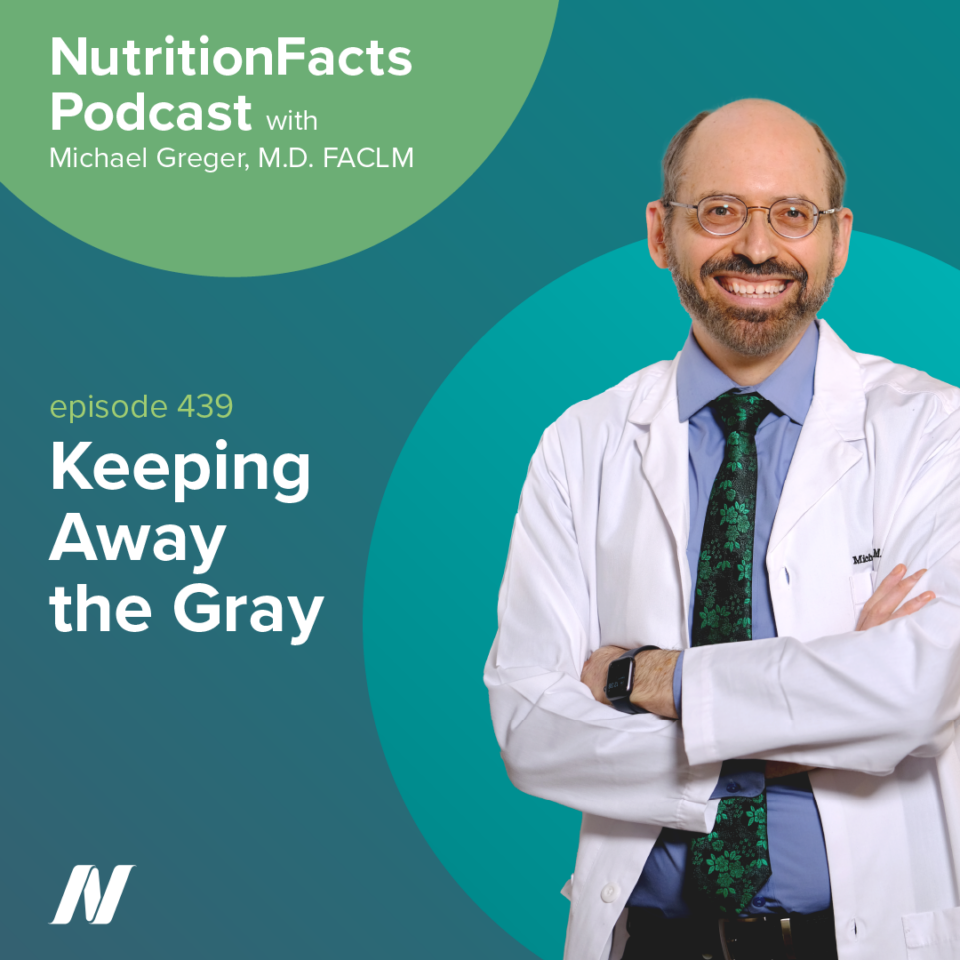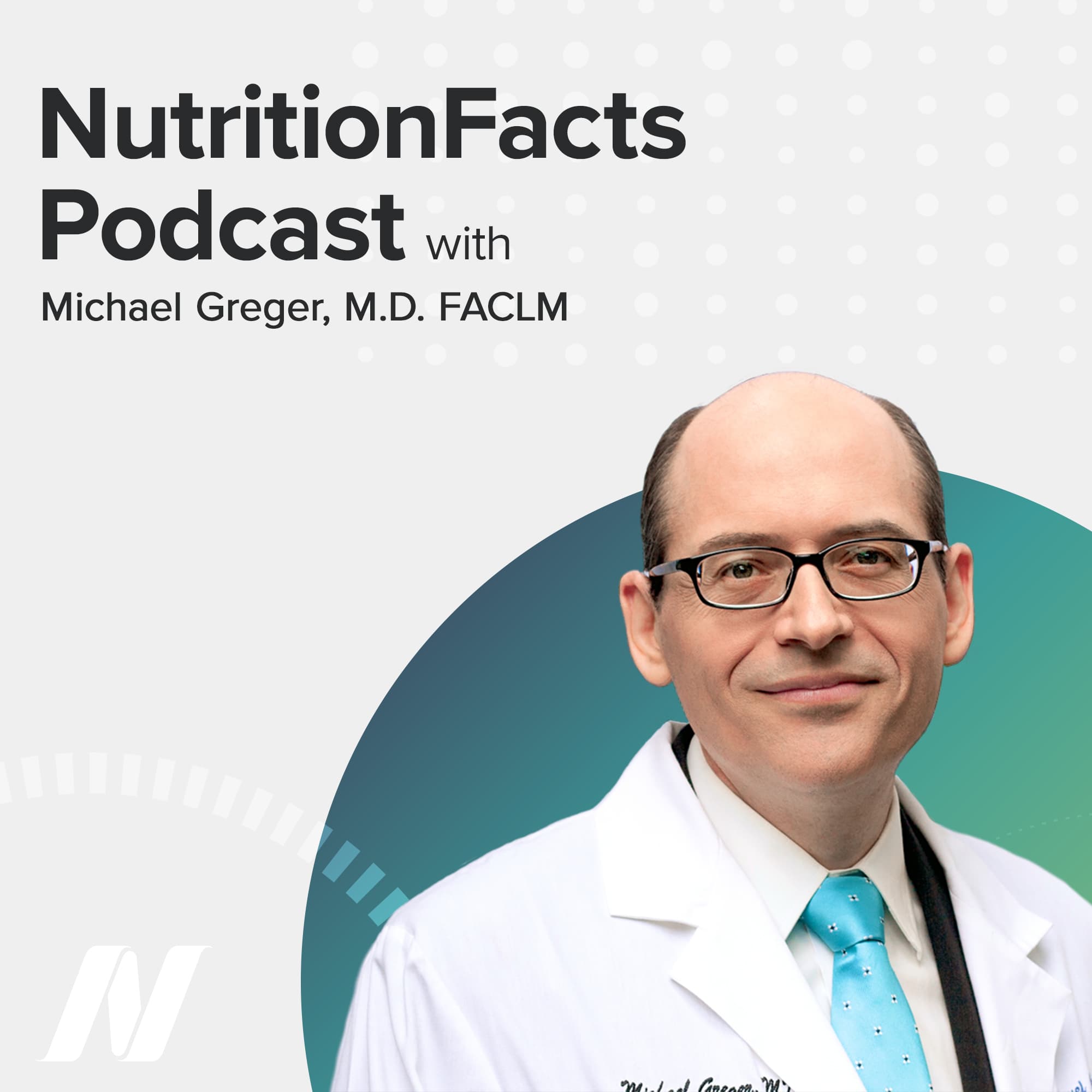The graying of hair is one of the most obvious signs of aging. It’s also known by a technical term that I had never heard of: “canities.” The first time I saw the word, I misread it, wondering what gray hair had to do with dentistry. Evidently, gray hair isn’t really white, but the pale yellowish tinge of the constitutive keratin protein. But, like polar bears, it just looks white by the way light reflects off of it. Why is hair pigmented in the first place?
Some suggest it may be for detoxification, as natural toxins like heavy metals bind to the pigment melanin to be excreted from the body through hair outgrowth. That’s why you can estimate the amount of fish consumption from the mercury content of children’s hair clippings. This is why “[a]nalysis of hair mercury may be warranted before pregnancy” in women who eat a lot of fish, and why the levels of mercury in the hair of those eating plant-based diets were found to be up to ten times lower than those who just occasionally ate fish. Within three months of switching to a plant-based diet, the levels of mercury, lead, and cadmium growing out in your hair appear to drop significantly, but build back up when meat and eggs are added back into the diet. Enough with the science trivia. What causes our hair to turn gray, and what can we do about it?
In medical school you learn about the so-called 50-50-50 rule. By age 50 years, the dictum goes, 50 percent of the population has at least 50 percent grey hair. But that was based on a homogenous population of largely white, fair-haired Australians. The global range is more like 6 percent to 23 percent are 50 percent gray by 50. Though not as memorable an axiom, it looks like about 75 percent of people between 45 and 65 years of age have about 25 percent gray hair.
Those of African or Asian descent tend to show less gray hair. White people generally start to gray in their mid-30s, Asians in their late 30s, and Africans in their mid-40s, such that premature graying is defined before age 20 in Caucasians, but before age 30 in African-Americans. Age 25 has been suggested as a cutoff for India. Premature or not, what causes hair to turn gray in the first place?
The hair follicle is a complex little mini-organ that anchors and grows a single hair. In the base of the follicle bulb, as few as 100 pigment-making cells normally stain the emerging hair shaft with melanin pigments that can range in color from black to red. A single hair grows for about 3.5 years before falling out, and a new one starts growing in its place. So, graying may start after about ten hair cycles, when pigment deposition declines as the pigment generating cells, called melanocytes, start to become depleted. What kills them off?
There’s a depigmentation disorder called vitiligo where melanocytes in the skin are killed off by a buildup of hydrogen peroxide, which can decompose into toxic free radicals. So, researchers checked, and indeed, the same “massive” levels were found in aging hair follicles. Where does the hydrogen peroxide come from? It’s naturally generated as a by-product of melanin synthesis, but normally countered by an antioxidant enzyme called catalase. The problem, it seems, is that catalase and other antioxidant defenses may decline as we age and leave melanocytes vulnerable to their own hot-potato production of pigment.
Our own eyelashes present “an enigma in plain sight.” Eyelashes tend to be the darkest hairs on the human body and undergo graying significantly later than other hairs. The explanation appears to be the presence of a particular antioxidant protein missing from regular hair, consistent with the prevailing “free radical theory of gray.”
The graying of hair, the age-related “exhaustion of the pigmentary potential,” is thought to be mainly genetic, with a family history of premature graying present in up to 90 percent of cases. But if the rate of graying is caused by oxidative damage, what role might be played by antioxidants and systemic oxidative stress outside of the hair follicle? Those with premature graying do seem to have higher circulating markers of oxidative damage and lower antioxidant levels in blood. The higher prevalence of premature graying among smokers also supports this possibility that exogenous free radicals may speed up the accumulation of oxidative insults in the aging hair follicle. Obese individuals also tend to gray early, consistent with the oxidative stress concept, though drinkers do not. Alcohol consumption clearly causes oxidative stress, yet is not significantly associated with premature graying.
Those trying to maximize their intake of antioxidants by eating plant-based must deal with the Achilles heel—the risk of vitamin B12 deficiency for those not actively supplementing their diets with B12 supplements or fortified foods. Vitamin B12 deficiency is one of the rare reversible causes of hair graying through some unknown mechanism. Thankfully, hair can repigment after B12 repletion. Another reversible cause is hypothyroidism, which can be reversed with thyroid hormone replacement.
Rather than oxidative stress, what about regular stress? Does fight or flight turn hair white? Marie Antoinette syndrome refers to the rapid graying of hair due to stress or trauma, based on the (likely apocryphal) story of her hair going completely white on the eve of her beheading. Sporadic validated reports of sudden graying have been attributed to the sudden diffuse loss of pigmented hairs, leaving the gray hairs behind, offering the illusion of transmogrification. In mice, acute stressors can lead to hair graying via rapid depletion of melanocyte stem cells, perhaps because psychological stress may lead to oxidative stress (based on cross-sectional studies that link higher perceived stress to higher levels of oxidative DNA damage).
Why might we even have evolved to turn gray in response to stress? Drawing on an analogy from the authority afforded silverback mountain gorillas, stress-induced greying may confer a “school of hard knocks” evolutionary advantage for leadership. For real-world consequences, check out the results of this study: hospitalized patients treated by gray-haired attending physicians were found to be significantly more likely to make it out of the hospital alive than those attended to by dark- or blond-haired docs. As a mark of age, gray hair may also be a mark of experience. But might having gray hair yourself increase your own chances of ending up in the hospital?
Might premature or extensive graying be a sign of accelerated aging and subsequent risk of age-related diseases? The data are mixed. Some studies suggest the degree of graying is an independent risk factor for coronary artery disease, for example, based on higher coronary calcium scores in grayer individuals. However, by far the largest study, which followed 13,000 men and women for 16 years, found no correlation between graying (or hair loss or wrinkles) and overall mortality. The only exception appeared to be a small fraction of men without any gray hair (just 6 percent of those in their 6, 2 percent of those 50s, and 1 percent of those in their 70s), who did seem to have a significantly lower mortality.

 Previous Podcast
Previous Podcast Next Podcast
Next Podcast